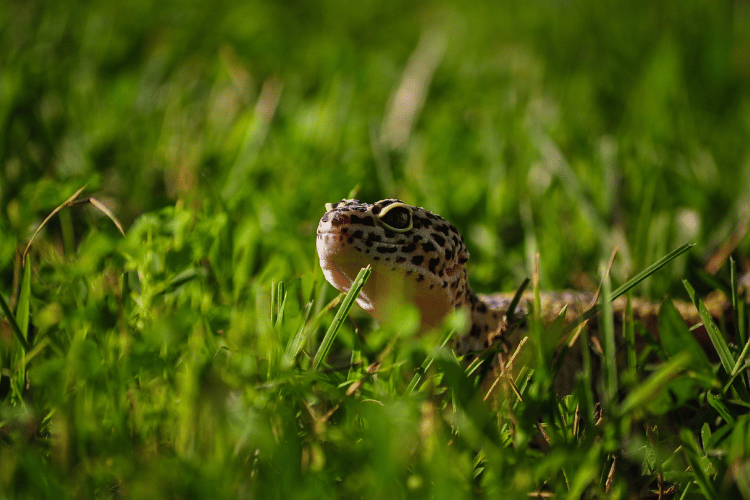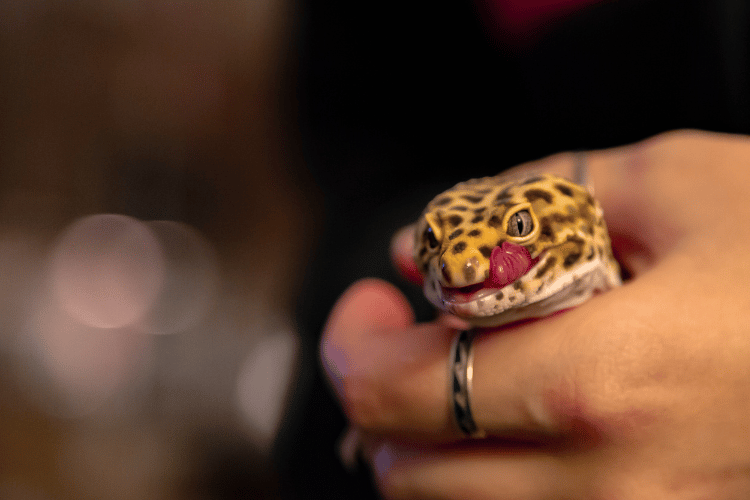In recent years, leopard geckos have surged in popularity as beginner pet lizards due to their enjoyable temperaments and relatively straightforward care.
As owners form bonds with their geckos, some may wonder if it is safe or healthy to take them outside for some natural sunlight, enrichment, and a change of scenery.
While brief, carefully supervised outdoor time is possible with extreme caution, there are considerable risks threatening these small reptiles in the uncontrolled outdoor environment.
Read on to learn more.
Why Pet Owners Want to Take Their Leopard Geckos Outdoors
Many first-time leopard gecko owners know that natural sunlight and an enriching, stimulating natural habitat are important for health and happiness.
Taking geckos out for some fresh air and sunshine seems like a harmless way to provide that. Specific motivations well-intentioned owners have include:
- Allowing them to bask in warm, natural sunlight—though they don’t technically bask.
- Giving them more space to roam and explore.
- Providing a change of scenery for sensory enrichment.
- Taking cute photos and showing friends.
- Misconceptions that it is inherently healthy and risk-free.
These owners likely do not fully grasp the multitude of dangers the outdoor environment poses to vulnerable pet leopard geckos though.
Risks of Taking Your Leopard Gecko Outside

There are many threats to a leopard gecko’s well-being and even survival outdoors.
As small ectothermic reptiles, they rely on carefully controlled external heat sources to properly regulate their body temperature.
Outside temperatures can shift quickly in the shade or sun leading to dangerously rapid onset of overheating or getting too cold.
Both extremes cause severe stress and potential health issues very quickly, even in short 5-10 minute windows. The dry air and intense sunlight also lead to dehydration risks even after only 30 minutes of exposure.
Beyond thermal and humidity regulation dangers, other risks of taking your pet outside include:
- High levels of unfamiliar stimuli that can cause anxiety and stress.
- Exposure to parasites like mites, ticks, and internal worm infestations.
- Potential ingestion or skin contact with pesticides, lawn fertilizers, and automotive chemicals.
- Easy escape into hiding spots in vegetation and inability to relocate them.
- Outdoor cats, birds of prey, rodents, and neighborhood dogs as predators.
Safety Precautions for Outdoor Leopard Gecko Time
While highly risky, very brief and closely supervised outdoor sessions may be possible under certain strictly controlled conditions.
However, extreme precautions must be taken, including:
- Sessions longer than 5-10 minutes at a time are never recommended.
- Constant vigilance monitoring ambient temperature to maintain 80-90 degrees Fahrenheit.
- Providing consistent access to a reptile-safe fresh water dish throughout.
- Careful advance inspection and selection of enclosed space free from potential toxins.
- Use a secure, escape-proof portable enclosure without loose substrate material.
- Harness/leash restraints to prevent escaping and hiding.
- Attentive behavioral supervision continuously for any signs of stress or danger.
- Immediately end the session and return indoors if any concerns arise.
Alternatives to Taking Pet Geckos Outdoors
While outdoor trips may seem like exciting enrichment, safe and effective sensory stimulation can be better achieved through careful indoor habitat adjustments:
- Create a naturalistic, desert-themed terrarium with full spectrum lighting.
- Use vitamin/calcium supplements instead of direct outdoor sunlight.
- Allow fresh air exposure by cautiously opening windows.
- Transport in a secure carrier for limited outdoor visual stimulation.
- Focus on providing an enriching indoor habitat they are adapted to thrive in.
Signs of Stress in Leopard Geckos
Owners attempting brief outdoor excursions must monitor their leopard gecko’s behavior closely for concerning signs of fear, anxiety, or overexertion from heat stress. Being attentive could save a pet’s life by enabling the return indoors at the first hint of trouble.
Stress indicators to watch for include darker blotchy body color from vasoconstriction, gaping mouth breathing signaling overheating, repeatedly closed eyes, and hiding attempts under enclosure furnishings.
Loss of normal hearty appetite even the next day hints metabolic processes may have been disrupted. Lethargy and avoidance of regular activity are also red flags that something has negatively impacted the gecko’s health and welfare.
By learning about leopard geckos’ body language, owners can catch issues early before they become advanced heat stroke, shock, or long-term immune deficiency.
Never force an unwilling gecko to remain outside just for sunlight exposure; respect behaviors urging a return to their secure indoor habitat.
Preparing a Portable Outdoor Enclosure
Leopard gecko owners still electing brief outdoor sessions must properly set up an escape-proof portable outdoor enclosure to maximize safety.
Opt for a sturdy container like an ice chest with small ventilation holes that allow good airflow. The bottom should be covered with paper towels, not loose substrate like sand where geckos can burrow hiding spots and not re-emerge. You can also opt for a small reptile carpet.
Include an enclosed mini hide box for security and a shallow water bowl for constant hydration access. Weighing down and anchoring corners of the portable habitat prevents tipping.
Strategically camouflaging part of the enclosure with decorative leaves also provides a shaded refuge mimicking natural crevices.
With mindful advanced preparation, temporary outdoor housing can mitigate, not eliminate, risks to frightened and vulnerable pet leopard geckos.
Common Owner Misconceptions and Justifications

Despite experts’ ubiquitous warnings, some leopard gecko owners persist that very brief outdoor excursions won’t seriously endanger their hardy pet reptile.
Common false rationalizations include:
“It’s just a minute, what’s the harm?”
- Fails to realize that a devastating heat stroke can occur in just minutes.
- Temperatures and humidity fluctuate rapidly outside.
“But wild geckos live outside!”
- Ignores the fact that captive-bred morphs lack survival instincts.
- The outdoors can stress even wild specimens.
“Natural sunlight is healthy!”
- Intense UV exposure depletes protective mucus layers.
- Excess sunlight prevents proper vitamin D activation.
“I’ll just hold the gecko the whole time.”
- Scared geckos can unpredictably bolt and leap, causing falls/injuries.
- Impossible to fully restrict mobility and climbing.
Wrapping Up
While the intentions of leopard gecko owners for outdoor time often involve providing healthy sunlight and enrichment, the significant risks must be seriously weighed.
Reptiles lack many defenses against outdoor environment threats like temperature swings, dehydration, toxins, parasites, and predators.
With extreme vigilance monitoring and preparations, brief excursions may be possible in limited contexts. However, focusing efforts on building a properly stimulating and secure indoor habitat better provides long-term health and happiness for your leopard gecko.
- Can Leopard Geckos Eat Silkworms? - March 11, 2024
- Do Leopard Geckos Climb? - March 4, 2024
- Do Leopard Geckos Bask? The Answer Will Surprise You - February 21, 2024
